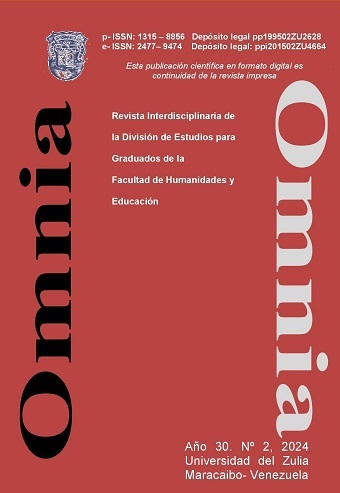Effectiveness of a teaching strategy based on B-Learning for learning Physics in secondary education
Abstract
Problems in Physics learning still persist, and students fail to build meaningful knowledge. The present study aimed to determine the effectiveness of a didactic strategy based on B-Learning for learning Physics in secondary education. This strategy consisted of incorporating multimedia technologies at different times in class. The methodology applied had a quantitative approach, with a quasi-experimental design; the technique was the survey and the instrument was a structured questionnaire with mixed-response items. The study was aimed at students in the 2nd year of Sciences, from the Niños Cantores Institute of Zulia. The results revealed that with multimedia technologies physical phenomena can be captured and understood more easily. In conclusion, it is highlighted that the B-Learning modality has several benefits: it facilitates learning, quick access to information, simplifies tasks, stimulates creativity and innovation and promotes communication
Downloads
References
Arrieta, Xiomara y Marín, Nicolás (2002). “Del experimento al concep-to”. Revista Encuentro Educacional, Venezuela. Vol. 9, No. 2, pp. 125-146. Extraído el 21 de abril de 2024. De: https://www.produccioncientificaluz.org/index.php/encuentro/article/view/4334.
Celada, Esther; Romero, Rafael; Márquez, Paco; Espíritu, Antony; Espi-noza, Miriam; Espinoza, Melvi; Gómez, Katerine; Valero, Vidnay y Gonzáles, Iris (2023). Estrategia B-learning para un desarrollo significativo: una revisión bibliométrica. Revista Bibliotecas. Ana-les de investigación, Cuba. Vol. 19, No. 2, pp. 1-15. Extraído el 13 de junio de 2024. De: http://revistas.bnjm.sld.cu/index.php/BAI/article/view/666.
Elizondo, María (2013). “Dificultades en el proceso enseñanza aprendi-zaje dela física”. Revista Presencia Universitaria, México. Vol. 3, No. 5, pp. 70-77. Extraído el 05 de abril de 2024. De: https://core.ac.uk/download/pdf/76588071.pdf.
Franco, Fredis; Pereira, Freddy; Ruiz, Kennya y Pereira, Freddy (2017). “Teoría y dificultades en el proceso de enseñanza y aprendizaje de la física en la antigüedad y actualidad”. Revista Científica Domi-nio de las Ciencias, España. Vol. 3, No. 4, pp. 419-430. Extraído el 17 de mayo de 2024. De: https://dialnet.unirioja.es/servlet/articulo?codigo=6325515.
García, Rosa; Aguaded, Ignacio y Bartolomé, Antonio (2018). “La revo-lución del blended learning en la educación a distancia”.RIED. Revista Iberoamericana de Educación a Distancia, España. Vol. 21, No. 1, pp. 25-32. Extraído el 27 de abril de 2024. De: https://revistas.uned.es/index.php/ried/article/view/19803/16901.
Hernández-Sampieri, Roberto y Mendoza, Christian (2018). Metodolo-gía de la investigación. Las rutas cuantitativa, cualitativa y mix-ta. Primera edición, McGraw Hill Education. Ciudad de México, México.
Islas, Claudia (2014). “El B-learning: un acercamiento al estado del co-nocimiento en Iberoamérica, 2003-2013”. Revista Apertura, Mé-xico. Vol. 6, No. 1, pp. 86-97. Extraído el 22 de marzo de 2024. De: http://www.udgvirtual.udg.mx/apertura//index.php/apertura/article/vie w/500/357.
Ramírez, Mirelle y Peña, Claudia (2022). “B-learning para mejorar el proceso de enseñanza y aprendizaje”. Revista Tecnológica Do-centes 2.0, Venezuela. Vol. 15, No. 2, pp. 5-16. Extraído el 10 de abril de 2024. De: https://ve.scielo.org/scielo.php?script=sci_arttext&pid=S2665-02662022000600005.
Salinas, Jesús; de Benito; Bárbara; Pérez, Adolfina y Gisbert, Mercé. (2018). “Blended learning, más allá de la clase presencial”. RIED.Revista Iberoamericana de Educación a Distancia, Espa-ña. Vol. 21, No. 1, pp. 195-213. Extraído el 09 de mayo de 2024. De: https://www.redalyc.org/journal/3314/331455825011/html/.
Velásquez, Óscar. (2019). “El nuevo rol del docente virtual para entor-nos virtuales de aprendizaje, el caso CEIPA”. Revista Lupa Em-presarial, Colombia. Vol. 1, No. 1, pp. 1-22. Extraído el 03 de mayo de 2024. De: https://revistas.ceipa.edu.co/index.php/lupa/article/view/401.





